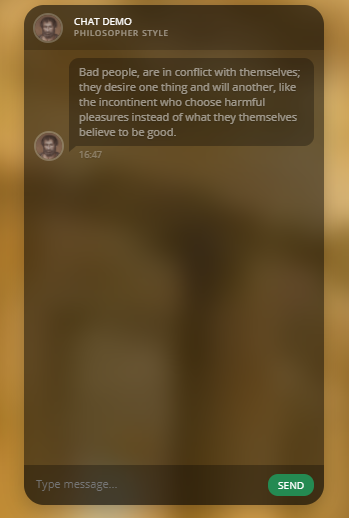Nikola Tesla
Imagineering institute chatbot Nikola was built with rule-based technology using n-grams. Nikola is implemented on Facebook Messenger. You can chat add him and chat with him via the following link
Nikola Tesla chatbot: https://www.facebook.com/nikolateslabot/
General Conversation
General conversation chatbot was implemented with AIML technology and customized conversations about Imagineering Institute. This chatbot was built for the project Analysis of the Chatbot Open Source Languages AIML and Chatscript: A Review.
General chatbot: http://iica.azurewebsites.net/
Donald Trump
For the Kazan Megatrend Forum project, two chatbots were created.
Trump chatbot was created with hybrid technology. We took the dataset from Donald Trump’s tweets on Twitter. Since the amount of data was not enough for chatbot creation and we didn’t have paired question-answers, we created a neural network model for tweets creation. We produced 30,000 tweets using this model. After we produced the tweets, we built a model for automatic question generation and produced questions for a tweets dataset. We used this dataset to train seq2seq LSTM neural network model and build a neural conversation agent. Then we built an AIML chatbot for factual questions using Trump’s answers from press conferences. In the end, we built a hybrid model for the chatbot with a combination of the neural network conversation agent and AIML chatbot. You can chat with the Trump chatbot on this link
Trump chatbot: http://iitrump.azurewebsites.net/
Michael Jackson
For the dataset of the Michael Jackson chatbot we used lyrics from his songs. The lyrics were the basis for dictionary creation. We used the LSI approach and genism Python library. Latent semantic indexing (LSI) is an indexing and retrieval method that uses a mathematical technique called singular value decomposition (SVD). LSI is based on the principle that words used in the same contexts tend to have similar meanings. A key feature of LSI is its ability to extract the conceptual content of a body of text by establishing associations between those terms that occur in similar contexts. When a question is passed to the chatbot, the chatbot will trigger a similarity checking and find the most similar sentence in the created dictionary.
Michael Jackson Chatbot: http://iimj.azurewebsites.net/
Aristotle Chatbot
Aristotle chatbot is created with same technology as a Michael Jackson chatbot. As a dataset for dictionary creation we use all Aristotle books.
Aristotle Chatbot: http://iiaris.azurewebsites.
TM Chatbot
Telecom Malaysia chatbot is a menu-driven, guided chatbot. This is a task-oriented chatbot with the purpose to guide users through the FAQs of Telecom Malaysia and give useful information to the TM clients.
TM chatbot: http://tmchatbot.azurewebsites.net/
Movie Chatbot
In the process of creating a movie style chatbot, we used a Cornel movie dialog dataset to train seq2seq LSTM neural network model in order to build Neural Conversational Agent: You can try our movie style chatbot on the link below.
Movie chatbot: http://iimovie.azurewebsites.net/
Project AI SnapChat Automatic Visual Conversation:
In this project, we used a model from “Show and Tell: Lessons learned from the 2015 MSCOCO Image Captioning Challenge.” The Show and Tell model deep neural network that learns how to describe the content of images. The Show and Tell model is an encoder-decoder neural network. It works by first “encoding” an image into a fixed-length vector representation, and then “decoding” the representation into a natural language description. The image encoder is a deep convolutional neural network. The decoder is a long short-term memory (LSTM) network. Words in the captions are represented with an embedding model. Each word in the vocabulary is associated with a fixed-length vector representation that is learned during training. We used beam search to generate captions for that image. Captions are generated word-by-word. We used the created model to produce captions for the incoming image-messages. Then we took images from the personal image folder and produced captions for them, and using Latent Semantic Indexing we found the most semantic similar caption from the captions of the image-message. Then our software agent produced image-response to the incoming image-message.
Visual Conversation: http://iipiccap.azurewebsites.net/
Project Voice Conversion:
The goal of this project is to convert an original audio file according to an applied style audio file. In the conversion process, content of the original audio file should be preserved. Neural style transfer is a model that uses Convolutional Neural Network (CNN) to transfer style from style image to original image. The original model is fed by image data. We used the same approach and transferred audio signal to the array and fed to the NN model. We also tried another approach, and converted an audio file to spectrogram image and fed the NN model in order to convert the original audio signal.
Voice Conversion: http://iivoicecon.azurewebsites.net/









